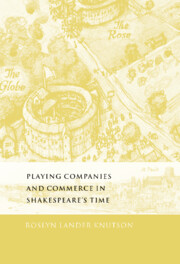Book contents
- Frontmatter
- Contents
- List of maps and tables
- Acknowledgements
- 1 Theatre history as personality
- 2 Players and company commerce
- 3 Playwrights, repertories, the book trade, and company commerce
- 4 Histrio-Mastix and company commerce
- 5 Hamlet and company commerce
- 6 Poetaster, Satiromastix, and company commerce
- 7 Conclusion: Hot Anger and company commerce
- Notes
- Bibliography
- Index
5 - Hamlet and company commerce
Published online by Cambridge University Press: 22 September 2009
- Frontmatter
- Contents
- List of maps and tables
- Acknowledgements
- 1 Theatre history as personality
- 2 Players and company commerce
- 3 Playwrights, repertories, the book trade, and company commerce
- 4 Histrio-Mastix and company commerce
- 5 Hamlet and company commerce
- 6 Poetaster, Satiromastix, and company commerce
- 7 Conclusion: Hot Anger and company commerce
- Notes
- Bibliography
- Index
Summary
This passage, notwithstanding the pains bestowed on it by the commentators, I do not understand.
John Lord ChedworthWhile it seems to be agreed upon all hands that Hamlet is the most topical play in the whole corpus, unhappily when it comes to interpreting the supposed allusions, agreement almost entirely vanishes.
John Dover WilsonTwo issues – text and theatre history – govern the interpretation of lines in Hamlet known as the “little eyases” passage, in which Rosencrantz banters about “an eyrie of children” who “cry out on the top of question, and are most tyrannically clapped for't” (2.2.337–39). The textual issue addresses the specifics of composition: when was the “little eyases” passage written and entered into Shakespeare's Hamlet? The issue of theatre history concerns the events to which the passage alludes: what was happening in the playhouse world that prompted the lines to be composed? In traditional as well as recent scholarly opinion, the issues have come together to enforce an interpretation that locates the event in 1601 when the War of the Theatres reached its height in an exchange of barbs between Ben Jonson's Poetaster at Blackfriars and Thomas Dekker's Satiromastix at the Globe.
This interpretation seems at first beyond challenge. It is based on textual decisions and an aggregate of commentary beginning with Nicholas Rowe in 1709. Yet consensus in the critical history of the “little eyases” passage is more apparent than real.
- Type
- Chapter
- Information
- Playing Companies and Commerce in Shakespeare's Time , pp. 103 - 126Publisher: Cambridge University PressPrint publication year: 2001



